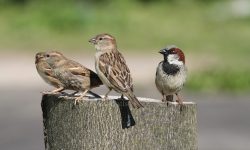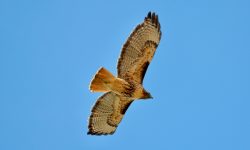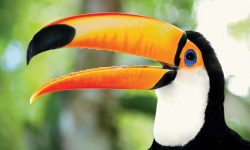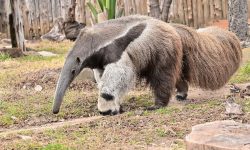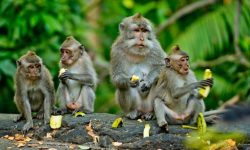The Yellow-breasted Chat (Icteria virens) is one of North America’s most enigmatic songbirds. Known for its bold colors, odd calls, and elusive behavior, this bird has puzzled scientists for decades. Although it was once grouped with warblers, the Yellow-breasted Chat is now in a class of its own — and for good reason.
In this article, we’ll explore why this bird carries such a vivid name and dive deep into its feeding habits with a list of ten foods it loves.
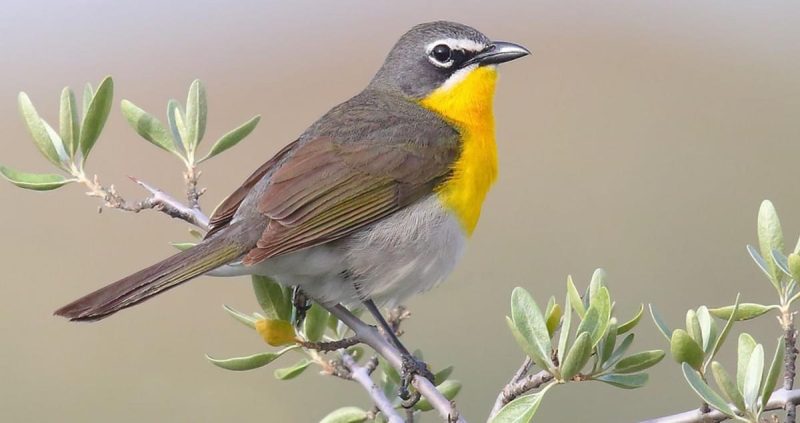
What Makes the Yellow-breasted Chat Unique?
Bold Plumage and Size
The Yellow-breasted Chat stands out immediately due to its size — far larger than the average warbler. While most warblers are delicate and petite, this bird stretches up to 7.1 inches in length with a wingspan approaching 10 inches, making it comparable in size to a small thrush. Its build is stocky, with a thick neck and long tail that give it a slightly awkward but powerful appearance in flight.
Its plumage is equally eye-catching. The upperparts are olive-green, helping it blend into leafy shrubs and dense undergrowth. But what truly grabs attention is its glowing yellow breast — a vivid splash of color that contrasts with the bird’s pale underparts. This yellow extends up the throat and is sharply divided from the white belly by clean lines. On its face, a bold white “spectacle” pattern — formed by white arcs above and below each eye, connected by a pale line across the lores — gives it a striking, almost cartoonish expression. This combination of brightness and facial markings adds an expressive, alert quality that’s uncommon among shy songbirds.
Unusual Vocalizations
Perhaps the most fascinating aspect of the Yellow-breasted Chat is its vocal behavior, which is unlike any other North American songbird. Unlike the melodious, flowing songs of true warblers, the chat’s vocalizations are a disjointed, often erratic medley of sounds: whistles, croaks, chuckles, cackles, harsh chatters, and even hoots. Males especially are known to perform extended “songs” that sound more like experimental audio tapes than birdsong — a jumble of mechanical and natural notes mixed with pauses, squeaks, and raspy calls.
What makes this even more intriguing is that these calls often come from deep within dense vegetation. The bird is notoriously hard to see, so hearing its odd outbursts — without being able to spot the source — creates a sense of mystery that frustrates birders and delights sound recordists alike. Some of its calls also seem to mimic other birds or environmental sounds, raising questions about its learning ability and neurological flexibility.
Habitat and Behavior
The Yellow-breasted Chat favors wild, tangled places that many people overlook: dense thickets, shrubby clearings, overgrown pastures, and riparian zones full of brambles and willows. It avoids the canopy and instead stays low, moving with stealth through the underbrush. This skulkiness makes it hard to observe, even when its song is blaring nearby.
Its behavior shifts notably during breeding season. While normally shy and reclusive, males become unexpectedly bold in spring and early summer. They often launch into exaggerated display flights, fluttering upward from a perch with slow wingbeats while singing loudly in mid-air, then dropping back into the thicket. These performances are both territorial declarations and mating displays, serving to attract females and warn off rivals.
Outside the breeding season, the chat reverts to secrecy. Its movements become more deliberate, and it relies on its olive tones for camouflage, often slipping silently through vegetation as it forages for insects and berries. This duality — bold showmanship in spring and quiet evasion the rest of the year — gives the Yellow-breasted Chat an almost theatrical character, as though it steps onto the stage only when the time is right.
Why Is It Called the Yellow-breasted Chat?
The name “Yellow-breasted Chat” is a combination of visual and vocal traits. The “yellow-breasted” part refers to its vivid lemon-colored chest — one of the bird’s most distinguishing features. The term “chat,” meanwhile, captures its chaotic and varied vocal behavior. Early ornithologists were baffled by its medley of sounds, which resembled a noisy conversation more than a bird song.
Its unique traits also led to decades of taxonomic confusion. Long classified with New World warblers, it was reclassified in 2017 into its own family: Icteriidae. Today, it remains the sole member of this family — a true oddball in the avian world.
What Does the Yellow-breasted Chat Eat?
Though not often seen, the Yellow-breasted Chat is an energetic forager. It feeds mainly in low shrubs or on the ground, hopping and fluttering while picking off prey or berries. It’s an omnivore that adapts its diet to seasonal availability.
1. Caterpillars
Caterpillars are a staple protein source during the breeding season. They’re abundant in summer and provide essential energy for adults and their young.
2. Beetles
Chats consume various beetle species, especially those found crawling on leaves and shrubs. Their tough exoskeletons are no problem for this bird’s strong bill.
3. Spiders
Spiders are another important protein source. The bird gleans them from foliage or plucks them from webs, showing impressive agility.
4. Grasshoppers and Crickets
During late summer, chats snap up grasshoppers and crickets found in meadows or tall grass. These insects are rich in fat and ideal for migration preparation.
5. Ants
Yellow-breasted Chats often feed on ants, which are plentiful and easy to find near the forest floor or under logs.
6. Wasps and Bees
Although riskier prey, chats occasionally eat wasps and bees, often neutralizing them by rubbing their bodies before swallowing.
7. Berries
Fruit is a critical part of the chat’s diet in late summer and fall. Berries provide sugars and hydration. Favorite types include elderberries, blackberries, and wild grapes.
8. Wild Grapes
These climbing fruits are nutrient-rich and widely available in riparian zones where chats breed. They’re consumed whole, seeds and all.
9. Dogwood and Sumac Fruits
Chats readily pick small red berries from dogwood and sumac shrubs, especially in migration stopover areas.
10. Seeds
Though not a primary food, chats occasionally ingest small seeds when fruits and insects are scarce, showing their dietary flexibility.
Seasonal Shifts in Diet
The Yellow-breasted Chat’s diet changes significantly with the seasons, reflecting the bird’s shifting energy demands and the availability of food in its habitat. This dynamic feeding strategy is crucial for survival, particularly during energetically demanding periods like breeding and migration.
Spring and Early Summer: Insect-Fueled Breeding
During spring and early summer, when chats return to their North American breeding grounds, their diet is overwhelmingly insectivorous. Protein-rich invertebrates such as caterpillars, beetles, spiders, and ants provide the essential nutrients needed for territory defense, courtship displays, and especially egg production. For females, the intake of high-protein prey supports the development of healthy eggs, while males require abundant energy for their elaborate flight songs and territorial battles.
As chicks hatch, the demand for insects intensifies. Nestlings require constant feeding, and soft-bodied larvae like caterpillars are ideal — easy to digest, nutrient-dense, and plentiful in spring foliage. Parents tirelessly forage through low shrubs and ground vegetation to gather enough food to meet their growing chicks’ needs.
Late Summer to Early Fall: Fruiting Season and Migration Fuel
As summer progresses, many insect populations begin to decline, and native shrubs enter peak fruiting stages. The Yellow-breasted Chat adapts accordingly, shifting its diet toward berries and soft fruits. This transition isn’t just opportunistic — it’s strategic.
Fruits like elderberries, wild grapes, and dogwood berries are high in sugars, making them excellent sources of quick energy. As chats prepare for their long migratory journey to Central America, these carbohydrate-rich foods help them build up fat reserves. In some habitats, fruit can make up the majority of a chat’s diet during this time, particularly in areas where insect availability has dropped.
The timing of this dietary shift aligns precisely with the bird’s physiological preparation for migration. Increased fat deposition, driven by a fruit-heavy diet, ensures that chats have enough fuel to survive long flights and potential stopovers across unfamiliar landscapes.
An Adaptive Strategy
This seasonal dietary flexibility allows the Yellow-breasted Chat to exploit a wide range of food sources across different stages of its life cycle. By consuming what’s most abundant and nutritious at each phase — insects in spring and fruits in fall — the species maximizes both reproductive success and migratory endurance. This adaptability is one of the key reasons the chat thrives in shrubby, transitional habitats where both insects and berries are seasonally abundant.
How Feeding Shapes Its Behavior
The Yellow-breasted Chat’s elusive reputation is deeply tied to its feeding strategy. Unlike many songbirds that forage in the open or flit conspicuously through treetops, the chat is a bird of the thickets — low, tangled vegetation where both its food sources and safety are concentrated. This preference for dense cover is not just a matter of camouflage; it’s a behavior rooted in survival and efficient foraging.
Skulking for Safety and Sustenance
By feeding in thick underbrush, the Yellow-breasted Chat can locate its preferred diet of insects and berries while remaining hidden from predators such as hawks, snakes, and even domestic cats. Its olive-green back blends into the foliage, and its movements are often slow and deliberate. This low-profile foraging behavior, sometimes referred to as “skulking,” is a classic strategy among birds that feed on or near the ground in exposed habitats.
Food availability reinforces this behavior. The shrubs and brambles that chats inhabit tend to be rich in caterpillars, spiders, beetles, and fruiting plants like wild grapes and elderberries. Rather than wasting energy flying between open perches, chats move nimbly through the tangled understory, hopping or fluttering from branch to branch as they feed just a few feet off the ground.
Seasonal Shifts in Visibility
Despite their usual stealth, Yellow-breasted Chats undergo a behavioral transformation during the breeding season, particularly males. To attract mates and defend territory, males emerge from hiding and become suddenly bold. They sing loudly, often from exposed perches or in mid-air, launching into exaggerated, fluttering display flights above the shrub line. This shift is temporary but striking — a trade-off between the need to attract a mate and the risk of drawing predator attention.
However, once courtship ends and nesting begins, the chat returns to its secretive ways. Both sexes vanish into the vegetation, rarely venturing into the open. Females incubating eggs and feeding chicks remain hidden for long periods, while males guard the area quietly, often without singing. Even though food gathering continues, it is done in near silence and deep cover, minimizing the chance of nest predation.
A Behavioral Adaptation to Habitat and Diet
This cyclical rhythm of visibility and concealment — bold in spring, cryptic in summer — is an elegant adaptation to the chat’s ecological niche. Its feeding behavior not only determines where it lives but also how it behaves, how it sings, and even when it chooses to reveal itself.
In essence, the Yellow-breasted Chat’s reputation as a “hard-to-see” bird is not due to shyness alone, but a carefully evolved balance between survival and reproductive success. Its behavior is a direct response to the landscape it inhabits and the food it pursues within it.
Conservation Status
Fortunately, the Yellow-breasted Chat is not globally threatened. It is listed as a species of Least Concern by the IUCN. However, habitat loss — especially the clearing of shrubby, early-successional woodlands — poses a localized threat. Restoration of dense brushy areas is essential for maintaining healthy chat populations.
Conservationists are now rethinking how to manage habitats traditionally seen as “overgrown,” recognizing that chats and many other birds rely on these tangled spaces to thrive.
Final Thoughts
The Yellow-breasted Chat is a bird full of surprises. From its loud, un-birdlike calls to its bright plumage and eclectic diet, it defies categorization. Its name captures both its visual charm and vocal strangeness — a fitting tribute to one of North America’s most intriguing songbirds.
Whether you hear its chatter from the thickets or catch a glimpse of that golden breast in flight, the Yellow-breasted Chat is a reminder that even the most elusive birds can have outsized personalities.


